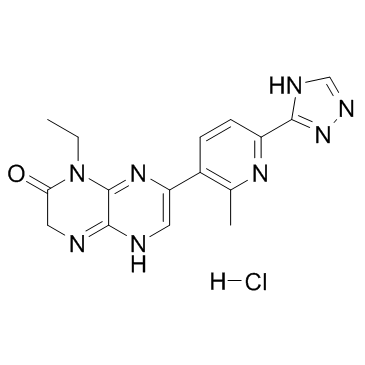CC-115 hydrochloride
Modify Date: 2024-01-02 19:00:05

CC-115 hydrochloride structure
|
Common Name | CC-115 hydrochloride | ||
|---|---|---|---|---|
| CAS Number | 1300118-55-1 | Molecular Weight | 372.812 | |
| Density | N/A | Boiling Point | N/A | |
| Molecular Formula | C16H17ClN8O | Melting Point | N/A | |
| MSDS | N/A | Flash Point | N/A | |
Use of CC-115 hydrochlorideCC-115 hydrochloride is a potent and dual DNA-PK and mTOR kinase inhibitor with IC50s of 13 nM and 21 nM, respectively. CC-115 blocks both mTORC1 and mTORC2 signaling. |
| Name | CC-115 hydrochloride |
|---|---|
| Synonym | More Synonyms |
| Description | CC-115 hydrochloride is a potent and dual DNA-PK and mTOR kinase inhibitor with IC50s of 13 nM and 21 nM, respectively. CC-115 blocks both mTORC1 and mTORC2 signaling. |
|---|---|
| Related Catalog | |
| Target |
DNA-PK:13 nM (IC50) mTOR:21 nM (IC50) mTORC1 mTORC2 PI3Kα:852 nM (IC50) |
| In Vitro | CC-115 inhibits PC-3 cells proliferation with an IC50 of 138 nM. In a kinase selectivity assessment against a panel of 250 protein kinases at 3 μM, only one kinase other than mTOR kinase is identified with more than 50% inhibition (cFMS 57%, IC50=2.0 μM). Of the PI3K related kinases (PIKKs) tested, CC-115 proves to be equipotent against DNA PK (IC50=15 nM) and demonstrates 40 to >1000 fold selectivity against the remaining PIKKs tested; PI3K-alpha (IC50=0.85 μM), ATR (50% inhibition at 30 μM) and ATM (IC50>30 μM). The IC50 values for CC-115 are >10 μM against a panel of CYP enzymes and >33 μM for the hERG (human ether-a-go-go-related gene) ion channel. When screened in a single point assay at 10 μM against a Cerep receptor and enzyme panel only one target is inhibited >50% (PDE3, IC50=0.63 μM)[1]. |
| In Vivo | CC-115 hydrochloride shows good in vivo PK profiles across multiple species with 53%, 76% and ~100% oral bioavailability in mouse, rat and dog, respectively. CC-115 is tested at lower doses of 0.25, 0.5 and 1 mg/kg bid or 1 mg/kg qd, with observed corresponding tumor volume reductions of 46%, 57%, 66% and 57% respectively. CC-115 sustains inhibition though 24 hours. At the 1 mg/kg dose CC-115 shows significant inhibition at 1 and 3 hours, CC-115 demonstrating inhibition through 10 hours. CC-115 is evaluated using both once (qd) and twice (bid) daily dosing schedules[1]. |
| Kinase Assay | An HTR-FRET substrate phosphorylation assay is employed for mTOR kinase. PI3Kα IC50 determinations are outsourced using the mobility shift assay format. Compounds (e.g., CC-115) are assessed against concentrations of ATP at approximately the Km for the assay, with average ATP Km of 15 μM and 50 μM for the mTOR and PI3K assays, respectively[1]. |
| Cell Assay | PC-3 cells are cultured in growth media. For biomarker studies cells are treated for 1 h and then assayed for pS6 and pAkt levels using MesoScale technology. For proliferation experiments, cells are treated with compound (e.g., CC-115) and then allowed to grow for 72 h. All data are normalized and represented as a percentage of the DMSO-treated cells. Results are then expressed as IC50 values[1]. |
| Animal Admin | Mice[1] Encouraged by the observed exposures, CC-115 is advanced into single dose PK/PD studies assessing mTOR pathway biomarker inhibition in tumor bearing mice. PC-3 tumor-bearing mice are administered with a single dose of CC-115, dosed orally at either 1 or 10 mg/kg, and plasma and tumor samples are collected at various time points for analysis. Significant inhibition of both mTORC1 (pS6) and mTORC2 (pAktS473) is observed for all compounds and the level of biomarker inhibition correlated to plasma compound levels. |
| References |
| Molecular Formula | C16H17ClN8O |
|---|---|
| Molecular Weight | 372.812 |
| Exact Mass | 372.121399 |
| Storage condition | 2-8℃ |
| Pyrazino[2,3-b]pyrazin-2(1H)-one, 1-ethyl-3,5-dihydro-7-[2-methyl-6-(4H-1,2,4-triazol-3-yl)-3-pyridinyl]-, hydrochloride (1:1) |
| 1-Ethyl-7-[2-methyl-6-(4H-1,2,4-triazol-3-yl)-3-pyridinyl]-3,5-dihydropyrazino[2,3-b]pyrazin-2(1H)-one hydrochloride (1:1) |
| CC-115 (hydrochloride) |